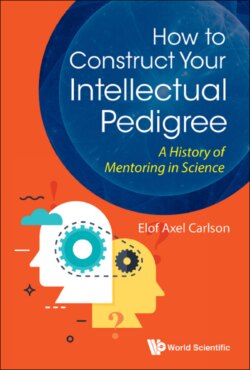Читать книгу How to Construct Your Intellectual Pedigree - Elof Axel Carlson - Страница 7
На сайте Литреса книга снята с продажи.
Preface
ОглавлениеI wrote this book so other scientists can construct their own intellectual pedigrees. This makes it a manual and I show that there is no one way to display such a pedigree. This gives the reader lots of choices about the information desired for display as well as the aesthetics of how such a pedigree will look. There are presently several phrases in use for this type of construction: intellectual pedigree, academic pedigree, mentoring pedigree (or fly tree, neurotree, etc.) and all seem reasonable to me. They convey an interest in that process by which knowledge is passed across generations through a variety of ways, the most intimate being a oneon-one relationship between an academic sponsor and a student.
Academics earning a PhD in a scientific research field are usually not trained to become effective teachers. In the life sciences the closest most graduate students come to that experience is their year or years spent as a teaching assistant (often designated by initials alone, “being a TA”). Most freshly minted PhDs learn from their errors or copy the habits of teachers they admired. Most become competent or excel at teaching, but they are cautioned not to overdo their enthusiasm for teaching because that will leave little time for research. The teaching usually at issue is the lecture course especially large courses for undergraduates. While communicating scientific ideas and information is essential for good teaching, there is another aspect that is rarely discussed. Good teachers are good mentors. Mentors are more likely to be associated with one-on-one encounters and nothing has a greater impact in a scientist’s training than the mentoring of a graduate sponsor for a dissertation research project. I knew that my mentor, Hermann Muller, spent many hours with me going over my research plans, meticulously editing my write-ups for projects and publishable papers, and encouraging me. He was also demanding in his expectations but never in the sense that I felt I was being exploited. In fact, he made sure his name did not appear on papers that I had conceived and carried out.
I began looking at mentoring relations of scientists by constructing my own intellectual pedigree. I used Sturtevant’s 1965 efforts as a guide. But Sturtevant did not provide information on the forerunners of Morgan’s legacy. Over the years I read biographical accounts of those in my pedigree and was surprised that I could push this mentoring sequence to notable icons of science like Newton, Darwin, or Galileo. This book reveals a lot of interesting findings and answers some basic questions. How did this mentoring system arise? How did it move from one country to another? How did fields shift in a lineage from mathematics or physics to biology? For those interested in the history, sociology, or philosophy of science, this approach to mentoring is new and what it might lead to is largely unknown. I hope readers will prepare their own intellectual pedigrees and place these on websites. I know little about attempts, if they exist, for intellectual pedigrees in major parts of the world — Chinese, Japanese, Indian, African, Middle East, and Latin American. I used primarily geneticists and traced their mentoring past as far as I could go. While there will be overlaps if this study were done for evolutionists, embryologists, cell biologists, biochemists, and microbiologists, I expect some differences would emerge by field. I included all the geneticists featured in Krishna Dronamraju’s book, A Century of Geneticists: Mutation to Medicine (2018).
Most of the reading for this I accomplished at home in Bloomington, Indiana. I also used the Wells Library and the Lilly Library at Indiana University for finding information I could not get on the web. I thank Abraham Krikorian and Krishna Dronamraju for their many helpful suggestions.
I thank my daughter Christina Carlson for help preparing the circular diagrams. I thank for helpful suggestions from Krishna Dronamraju, Abraham Krikorian, Shari Cohn, Caitlin Carlson Jones, and many students who supplied information on their careers. For the 36 illustrations in this manual, see the Afterword for information on their sources. All, unless noted otherwise, are from the web and are in public domain because they were published before 1989 in United States publications, or before 1923 (international).
Elof Axel Carlson
Bloomington, Indiana
Emeritus Distinguished Teaching Professor, Stony Brook
University, New York, and
Visiting Scholar and Fellow, Institute for Advanced Study,
Indiana University
